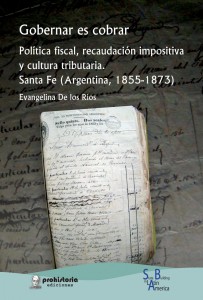Gobernar es cobrar. Poder fiscal, recaudación impositiva y cultura tributaria. Santa Fe (Argentina, 1855-1873)
Evangelina de los Ríos
Resumen
El libro indaga en la conformación del Estado desde un ángulo particular, el fiscal. El análisis de sistemas fiscales resulta de suma utilidad para iluminar aspectos poco estudiados del proceso de consolidación de la autoridad estatal ya que, como es bien sabido, Estado y fiscalidad fueron y son, dos caras de una misma moneda que no pueden separarse conceptualmente. La política fiscal adoptada por sus gobernantes refleja tanto las relaciones de poder en su interior como el carácter de la sociedad. Al tiempo que, permite penetrar sutilmente en los objetivos y prioridades que animaban a quienes concibieron esas medidas. En el contexto estudiado, la provincia de Santa Fe en el tercer cuarto del siglo XIX, la reorganización del sistema fiscal fue concomitante a un debate sobre el diseño institucional y administrativo requerido para usufructuarlo de la manera más adecuada. El objetivo de mi investigación era estudiar los modos en que se recaudaban los impuestos y se resolvían las contingencias ligadas a esta cuestión. Pretendía dar respuesta a dos preguntas centrales: cómo se cobraban los tributos y quiénes eran los recaudadores. El trabajo se estructuró en tres partes. En la primera se examinaron los mecanismos de construcción espacial (con eje en las relaciones sociales) y territorial (con eje en el equipamiento político) de Santa Fe. Proponía un recorrido por el proceso de configuración territorial tomando en cuenta los avances y retrocesos que sufrieron las fronteras así como también los esfuerzos de las autoridades estatales de dar territorialidad a la gestión fiscal. La capacidad de obtener recursos demandaba un profundo conocimiento del territorio, la población que lo habitaba –su base tributaria- y el espacio económico en el que se inscribía (circulación de mercancías, producción y relaciones comerciales). En pos de mantener equilibradas las finanzas, las autoridades debieron hacer frente al desafío de dotar de recursos al erario y lograr, al mismo tiempo, el consenso entre los contribuyentes. El último aparado esta dedicado a estudiar al detalle la administración tributaria; prestando especial atención a modos de recaudación y percepción concreta de impuestos. Un enfoque a nivel de la gestión cotidiana permite apreciar las prácticas de los agentes, quienes, entre bien público e interés privado, procuraban alcanzar su cometido, exhibiendo aún fuertes pervivencias de Antiguo Régimen.
Abstract
The book investigates the configuration of the State from the specific point-of-view of fiscality. The analysis of fiscal systems is of great usefulness, as it sheds light on aspects of the process of consolidating the State´s authority that have not been studied in depth, for, as it is well-known, the State and taxation were and are two sides of the same token that cannot be conceptually separated. The fiscal policy adopted by rulers reflects the power relations forged in the interior of the State as well as the character of the entire society. At the same time, it allows us to delve subtly into the objectives and priorities that inspired those that conceived these measures. In the specific context that we studied, the province of Santa Fe during the third quarter of the nineteenth century, the reorganization of the fiscal system was concomitant with debates about the institutional and administrative design that was required to make use of it in the most appropriate way. The objective of my investigation was to study the methods employed to collect taxes and resolve the ensuing contingencies. It tried to answer two fundamental questions: how taxes were collected and who the tax collectors were. The dissertation was structured in three parts. The first part examined the mechanisms of the spatial construction (with social relations as the central focus) and territorial construction (with the political structure as the central focus) of Santa Fe. It offered an overview of the process of configuring this territory by taking into account the advances and retrocessions that the borders underwent as well as the efforts that the State´s authorities made to manage the territories for fiscal purposes. The capacity to obtain resources required a profound understanding of the territory. The population that lived there-their fiscal base- and the economic space in which it was comprised (circulation of merchandise, production, and commercial relations). In the second part, I studied exhaustively the reforms undertaken by the provincial administration in pursuit of obtaining more revenues and in turn, the way in which expenditures were administered. In order to maintain the government´s finances balanced, the authorities had to take on the challenge of providing resources to the public treasury all while managing to maintain the taxpayers´ consensus. The last part is devoted to studying in detail the administration of the taxation office; I therefore paid particular attention to the ways in which taxes were collected and the concrete process of levying taxes. Focusing on the everyday administration allowed me to detect the collectors´ specific practices as they, torn between the common good and their personal interests, tried to complete their assigned tasks. Their practices continued to reflect the persistence of the Old Regime.
Evangelina de los Ríos, Gobernar es cobrar. Poder fiscal, recaudación impositiva y cultura tributaria. Santa Fe (Argentina, 1855-1873), Rosario: Prohistoria Ediciones – State Building in Latin America, 2017.
 Español
Español 